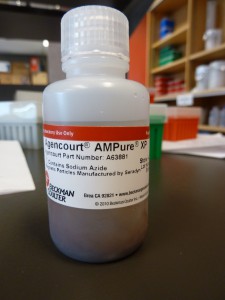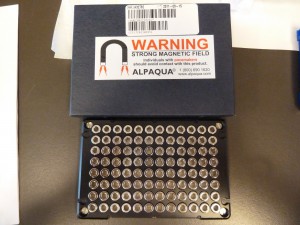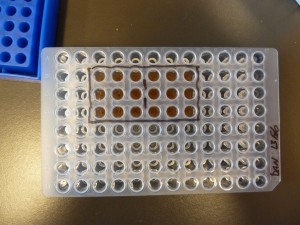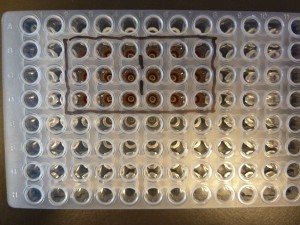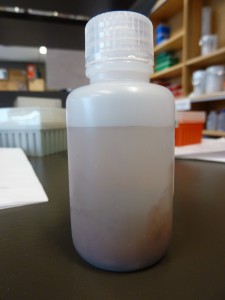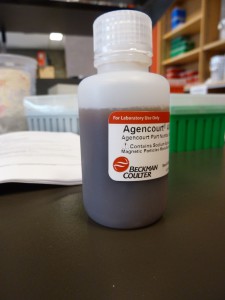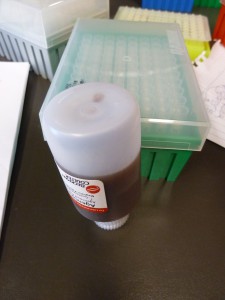Ampure XP magnetic beads have become popular for cleaning DNA from reactions and for size selecting DNA. WGS sequencing library preparation protocols, and the GBS protocol, involve one or more bead clean up steps. If you make next gen sequencing libraries you will use Ampure XP beads. Following is some basic information about them and my thoughts about using them, mainly for library preparations . . .
What are Ampure XP beads?
Ampure XP beads are a product sold by Beckman Coulter as “Agencourt AMPure XP”. (Agencourt was a biotech company that Beckman Coulter bought in the naughties and, presumably, the beads came with them). The brown beads are microscopic, you can’t see individual beads with the naked eye, and they are sold in a clear buffer. They are not cheap, the 60ml bottle we bought in August 2011 cost $1152, shocking. The 96 well magnetic stand we got at the same time cost $890, also shocking.
The key characteristics of the beads is that they are magnetic and DNA sticks to them. Even more special – it is possible to bias the DNA molecules that stick to the beads by length. These three features mean that Ampure XP beads can be used to clean DNA from reactions and to bias that recovered DNA by size.
A note on terminology: these beads are often referred to as “SPRI” beads. SPRI is an acronym for Solid Phase Reversible Immobilization, sounds important doesn’t it?
Ampure XP beads are used in liquid handling robots to automate DNA purifications from reactions. We don’t have access to one of these robots but we can still use the beads – you will be the pipetting robot/monkey.
Here is a pdf of a promotional presentation (slides) from Beckman Coulter extolling the merits of XP beads over plain old Ampure beads. It shows some useful information.
This is the product webpage at Beckman Coulter.
Here is the Beckman Coulter protocol for using the beads to clean DNA from a PCR.
Here is a WGS sequencing library preparation protocol that has several Ampure XP bead clean up steps in it.
Here is a pdf of the price list for related items from Beckman Coulter as of June 2011.
How do they work?
I’m not a chemist so I’m not going to claim to understand what happens at the molecular level when Ampure XP beads meet DNA. That said, it is interesting and the general principles aren’t difficult. This is a thread at SEQanswers about how the beads work.
Simple version: the beads are in a buffer with salt and/or PEG which makes DNA precipitate. The precipitating DNA has an affinity for the surface of the beads and sticks to it. You take advantage of this and do a magnetic two-step . . .
- You hold the beads in the tube or plate with a magnet while you draw off the reaction volume. You now have the DNA you want stuck to the magnetic beads and effectively none of the other components of the solution you started with.
- With the beads (and DNA) immobilised by the magnet you can rinse them with ethanol just like you would a DNA precipitate pelleted by centrifugation.
- Then the beads are “freed” by taking the tube or plate off the magnet, dried, then resuspended in water or an aqueous buffer like TE. With the beads floating around in such a buffer the DNA dissolves off them into solution.
- Then, to get rid of the beads, you can put the tube or plate back on the magnet to hold the beads while you aliquot the DNA solution into another tube or well.
The more complicated version with size selection: The protocol provided by Beckman Coulter (see above) is designed to bias the DNA recovery away from very small DNA molecules. This default protocol is intended for people, or robots, cleaning DNA from PCRs where the goal is to recover amplicons but avoid recovering primers and primer-dimers. For this reason the protocol is designed to recover molecules longer than 100bp. This minimum size threshold can, however, be tweaked and if you do a magnetic three-step instead of the two-step described above you can achieve a size selection at both the top and bottom of a size range – see below. But first . . .
Tweaking the minimum size threshold for DNA molecules recovered by Ampure XP beads: Its all about precipitation and the buffer the beads are in not the beads themselves. You can think of the beads as just the thing that the DNA precipitates onto – they catch the DNA that the buffer causes to precipitate. The higher the ratio of bead buffer to water the more effective the precipitation of DNA molecules will be. Because of chemistry or physics or something, bigger DNA molecules precipitate easier than smaller DNA molecules. You need less salt in an aqueous DNA solution to make big DNA molecules precipitate than you need to get small DNA molecules to snap out of solution. With this in mind, the logic of moving the minimum DNA molecule size recovered by the beads up and down is simple – you make the precipitation less or more effective by moving the ratio of bead buffer to water down or up.
- Less bead buffer = less effective DNA precipitation = higher minimum bp of recovered DNA molecules.
- More bead buffer = more effective DNA precipitation = lower minimum bp of recovered DNA molecules.
Note that its all about the buffer not the beads, however, you are obviously also changing the concentration of the beads themselves when you modify the amount of buffer you use. The beads come in the buffer – add less of the buffer and you also add fewer beads. Obviously, there is scope for affecting the yield of recovered DNA by adding too few beads. Presumably, you could modify the precipitation chemistry by adding beads to a separate source of the precipitation buffer. However, as you will see below, the range of bead buffer/bead ratios involved in the size selections for WGS library preps is quite small and my guess is that the beads are at close to “saturation” levels in the default protocol and that small changes in bead concentration don’t matter much in terms of catching all, or almost all, of the DNA that is precipitated.
Size selection bottom end only:
- as per the simple version above but with less bead buffer/beads added to the reaction volume if you want to bring the minimum size threshold up from the 100bp threshold of the default protocol. The Beckman Coulter protocol calls for a 1.8X volume of beads added to a 1X volume of reaction (you’d add 18ul of beads to a 10ul reaction for example) and aims to recover everything above 100bp. There is a bead step in the Bioo Scientific WGS sequencing library preparation protocol that calls for a 0.88X volume of beads (44ul beads + 50ul reaction) in order to avoid recovering (i.e. avoid precipitating) a reaction byproduct that is 120bp long (Illumina adapters ligated to each other instead of to inserts). There is another bead step in the same protocol that calls for a 0.85X volume of beads (42.5ul of beads + 50ul reaction) in order to avoid recovering anything smaller than 300bp.
Size selection top and bottom: this a magnetic three-step, c.f. the two-step above.
- Add the volume of beads to your reaction that will exclude, i.e. not precipitate, fragments shorter than those you want. For example, a 1.8X volume excludes molecules up to 100bp, a 0.85X volume excludes up to 300bp (note that these examples are from protocols where the salt concentration of the reaction volume is set in earlier steps and that variations in salt concentration of the starting reaction might affect the size threshold).
- On to the magnet and draw off the liquid. The beads have captured the precipitated DNA above the minimum threshold and you’ve just removed the smaller DNA molecules.
- Wash the beads with ethanol then, off the magnet, dry the beads and resuspend them with an appropriate buffer (10mM Tris for example). The DNA molecules above the minimum size threshold will now be in solution off the beads.
- Back on the magnet and transfer the DNA solution to a new tube or well. This gets rid of the beads.
- Add an even smaller volume of beads (by ratio) to the recovered DNA solution from the first bead purification. The objective here is to bind the larger DNA molecules that you DON’T want to the beads and to leave the smaller DNA molecules that you DO want in solution.
- On to the magnet. Transfer the liquid to a new tube or well leaving behind the large DNA molecules that are bound to the beads that are held by the magnet.
- That is it. The size selection, at both a minimum and a maximum size, has been achieved at this point. However, due to the addition of volumes in the last bead step (the recovered volume from the first bead step plus the volume of bead buffer that is added to it and then transferred) the DNA solution with the top and bottom size selection will be in a fairly large volume. The Bioo Scientific WGS sequencing library preparation protocol that has an Ampure XP bead size selection in it follows the above two bead steps with a third “normal” bead step where the DNA you want is precipitated onto the beads and then dissolved off them in a much smaller volume.
What they look like in action

Beads dried in PCR plate (prior to DNA recovery). Note that the magnet encircles the well so the beads form a ring part way up the well.
Tips
First, if you are not following a protocol worked up by someone else, like a biotech company, I recommend testing Ampure XP bead size selections before doing anything important. You need to get the bead-buffer to starting reaction ratio right for whatever size selection you are aiming for. The size bias in the DNA precipitation onto the beads will potentially be affected by the chemistry of your starting reaction as well as the bead mix itself. For this reason it would be a little optimistic to think that you could guess the bead mix to starting reaction volume ratio.
Second, I have found two problems with Ampure XP bead cleanups . . .
- Pipetting accuracy. The beads do not pipette well. The bead suspension clings to the outside of pipette tips and its easy to add some microlitres extra of the beads via the outside of tips. This can really matter. If you read the stuff above about size selection you might have noticed that the volume differences that shift the minimum size threshold for DNA molecules precipitating onto the beads up and down are quite small. The Bioo Scientific protocol, for example, has a step where 44ul of beads is added to a 50ul reaction to bind at 300bp and above and another step where 42.5ul of beads is added to a 50ul reaction to bind at 400bp and above. So a difference of only 1.5ul in this protocol shifts the minimum binding threshold by 100bp. In my experience, it is very easy to add much more than 1.5ul of extra beads from the outside of a pipette tip and therefore shift a minimum size precipitation threshold arbitrarily downward by hundreds of bp when the reaction volume is small. I would guess that it is possible to “accidentally” add 10ul or more from droplets clinging to the outside of a tip.
- Bead transfer with final elute. I use the beads in a 96 well PCR plate format with a 96 well magnetic stand (see images above). I find that its almost impossible to transfer almost all of the final aqueous elute off the beads without taking some of the beads. This is not how its supposed to work and the Beckman Coulter people make it sound like it shouldn’t happen. The problem seems to be related to the aqueous solution – the same problem doesn’t happen at the ethanol steps, its easy to pipette off all of the ethanol without taking beads. My guess is that the surface tension of the aqueous solution is greater than ethanol and that it drags beads down off the magnet. Basically, the magnet is not strong enough to hold the beads up as the meniscus passes it. Its very annoying. The only solution seems to be to add more volume and to leave some of it behind. In many cases the concomitant reduction in yield won’t matter. It should be said that, so far, I haven’t had any downstream problems with bead cleaned DNA solutions that are contaminated with beads. I try to avoid transferring the contaminating beads when I take an aliquot of a bead cleaned DNA solution by doing it on the magnetic stand (hoping that the magnet will hold the contaminating beads). Note that although you might think that contaminating beads would interfere with downstream applications by “binding” up some of your precious DNA that will only be the case if the chemistry of whatever you are doing causes DNA to precipitate. A more general concern about contaminating beads is that apparently the beads “shatter” when frozen. So, if you freeze your bead-cleaned DNA with some beads in there they might break down into smaller fragments – who knows if that will matter.
Resuspension: Other than those two problems there is also the inherent issue with the beads of resuspending them fully before taking an aliquot. The beads are shipped in a 60ml Nalgene bottle. To make pipetting easier I take an aliquot from the bottle into a 1.6ml tube. Obviously the beads need to be in a homogeneous suspension before taking an aliquot or you will get more or less of the beads than you should. Be very conscientious about mixing the bead stock until homogeneity is achieved before taking an aliquot. You will negatively affect the stock as well as your aliquot if you don’t. It can take several minutes of vigorous swirling and inverting of the bottle to make the suspension homogeneous. If you look hard enough at the images below you will see that its easy to visualise the homogeneity of the bead suspension.
Check the bottom of the bottle for unsuspended beads
If you use Ampure XP beads for size selection where it matters, e.g. preparing Illumina sequencing libraries, be very careful to fully resuspend settled beads and, more importantly, to add the right amount of bead mix to the DNA solution you are size selecting from. Be very careful about adding extra bead mix in droplets on the outside of your pipette tips. If you are concerned about contaminating beads in downstream applications or in the freezer modify your protocols so you can leave several microlitres behind at the last elution step off the beads – in my experience leaving about 3ul helps a lot.
That’s it, good luck.
Dan E.

